Archive for ‘Students’ Category
Take Note: Paper Doll’s Guide to Organized Note-Taking for Learning and Creative Projects (Part 3)
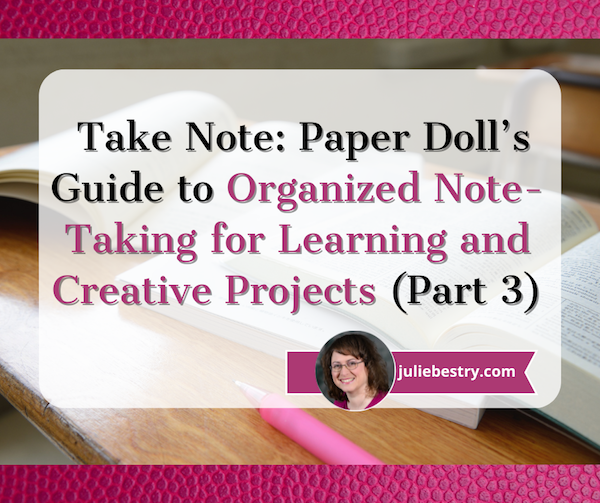
Two weeks ago, in Take Note: Paper Doll’s Guide to Organized Note-Taking (Part 1), we looked at the wide variety of situations in which you might take notes, and took a side journey into the relative merits of handwritten vs. digital notes.
Last week, in Take Note: Paper Doll’s Guide to Organized Note-Taking in Lectures & Presentations (Part 2), we explored solutions for taking notes when someone is imparting information to you verbally: in class, watching a webinar, attending a conference, and in collaborative meetings. Some variation on these methods work for casual note-taking situations, like when you’re learning about a diagnosis or treatment, you’re hearing about a new program at a PTA meeting, or even when you’re fielding information on a phone call.)
Whether you want to capture information for a later test, to improve your professional (or passion project) success, or help your team hit its action items, taking notes ensures that information can be captured, processed, learned, and acted upon.
Using my colleague Linda Samuels’ rubric, we looked at how to “listen, capture, and engage” with information using text-based note-taking (e.g., the sentence method, outlining, and the Cornell Note-Taking Method) and visual note-taking (e.g., mind mapping and sketchnoting).
We also harkened back to the idea that not all note-taking depends on information coming to you verbally. When you’re studying printed material as part of coursework, doing academic research (like a term paper on Alexander Hamilton) or writing a non-fiction book (like the history of sandwiches), you will need to take notes on what other people have written to achieve your goals.
You may also create notes from scratch, not based on someone else’s concepts (presented verbally or in writing), but invent something totally new with the help of the elves in your brain. You might write the score for a Broadway musical, engineer the schematics for a cool invention you aim to patent, or draft a novel about vampires from Jupiter or grandmother protesting injustice, or vampire grandmothers…
With modifications, you can take notes using the methods we discussed last week, but there are also note-taking methods that help you create and organize notes on non-verbal content.
ANNOTATION
Picture yourself studying for an exam or preparing to give a speech to your colleagues. However much material you already know, there’s going to be a larger chunk of the unknown printed in books, journal articles, and online.
The advantage of taking notes on what you’re reading is that you can take it at whatever speed you need to make sense of the information and organize it, combined with your own thoughts, without having all the inbound knowledge outpace you. The main disadvantage is that, unlike when a speaker accents what’s important (with voice, body language, or saying, “Hey, you numbskulls, this is going to be on the tests!”), text may not give you a clue as to what is vital.
Sure, textbooks may have concepts in bold or italics, but novels will not; if you’re reading the Federalist Papers, there’s no formatting to clue you in on what Alexander Hamilton (yes, him again!) thought was key. And if you’re researching to support your creative endeavors, only you know what will hit the spot.
Key Benefits of Annotating
Annotating enhances comprehension by allowing you to actively engage with the text, identify key points (either what the writer thinks is key or what is key for your purposes), ask yourself questions (so you can find answers in the text or in other resources), and record your own thoughts.
Annotation can lead to a deeper understanding of the printed word, making it easier to recall information later and prepare for discussions, writing assignments, or drafts. Annotating your notes reaps the following benefits:
- Improved comprehension — By highlighting important information and adding notes, you’re forced to actively process the text, leading to better understanding and retention.
- Critical thinking — Annotating pushes you to question the author’s arguments, identify biases, and form your own interpretations. In fact, as described in the New York Times article, How Students and Teachers Benefit From Students Annotating Their Own Writing, annotating improves metacognition, or thinking about how you think about something.
- Active engagement —The very act of writing notes as you read encourages focused attention and deeper engagement with the material. You’re less likely to let your eyes glaze over if you’re annotating the material.
- Organization of ideas — Annotations can help you identify the main points, structure of the text, and see how different concepts relate to one another. Sometimes it happens as you are annotating; other times, the act of annotating creates the magic that helps you see how things are connected later. If you’ve ever seen the TV show The Good Doctor, this is the way we see Dr. Shaun Murphy arriving at life-saving connections.
- Customization — You can add your own thoughts, reactions, and connections to the text, making the reading experience more meaningful. Whether you’re studying for a test or bringing concepts together to write a book, you can add your own metaphors or connections (and references to pop culture!) to make it resonate.
- Preparation for writing — Annotations are first drafts. They’re the key to making someone else’s first line of research into a foundation for your own work, whether you’re writing essays for Medium, research papers for a class, or a work project where you need to analyze and synthesize information from varied sources.
Analog Methods of Annotating
Marginalia
If you’ve ever scribbled notes, comments, or questions in the margins of a book, you’ve been annotating. You’ve done the active reading and critical thinking referenced above, and created a personal dialogue with the author of which only you are aware. (That’s OK, some authors are cranky and don’t welcome questions.)
Marginalia are great for when you want a quick reference for future review of the material. Last week, I was in a book club Zoom for the National Association of Productivity and Organizing Professionals’ Authorship and Publishing Special Interest Group (no surprise, we call it the NAPO A&P SIG), discussing On Writing Well: The Classic Guide to Writing Non-Fiction by William Zinsser.
Our leader, my colleague Deborah Kawashima, had extensive marginalia, and used those notes to lead the discussion — and to find related material when members brought up points.
I can’t bring myself to write in books — my first job was working in a library, and books are so sacrosanct to me, I can’t bear to even make a pencil notation. I use sticky tape flags combined with handwritten notebook pages for the short term (like a book discussion) and either handwritten or digital notes when working on a blog post or book project.
Take Note: Paper Doll’s Guide to Organized Note-Taking in Lectures & Presentations (Part 2)
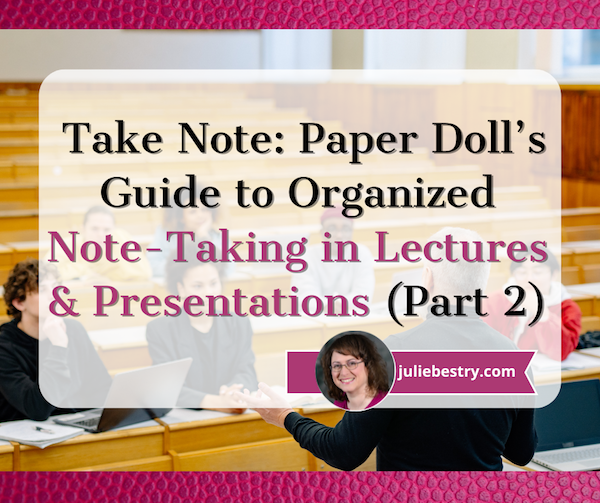 In last week’s post, Take Note: Paper Doll’s Guide to Organized Note-Taking (Part 1), we looked at the variety of situations in which we might take notes. Of course, it’s instinctual to think of classroom notes or notes in meetings first, but as we reviewed, we take notes all the time in other ways.
In last week’s post, Take Note: Paper Doll’s Guide to Organized Note-Taking (Part 1), we looked at the variety of situations in which we might take notes. Of course, it’s instinctual to think of classroom notes or notes in meetings first, but as we reviewed, we take notes all the time in other ways.
To review, we take notes on other inbound information:
- non-academic learning and skill acquisition
- at conferences, in webinars, and at professional lectures
- in collaborative meetings
- situationally, such as when we’re learning about a diagnosis or a new project, or we’re fielding information captured on a phone call
- in legal and financial situations, such as when conversing with professionals providing guidance
- when we’re gathering quickly-changing information when dealing with a crisis situation
In the comments for that post, my colleague Linda Samuels described the process as “Listen, capture, and engage” and that’s exactly the case when someone (a lecturer, a presenter, a group of people in a meeting) are speaking.
However, we’re not always listening and porting someone else’s spoken thoughts into our notes.
Quite often, the categories of note-taking involve figuring out for ourselves what is important and worth capturing, such as when we do research or plan travel. And sometimes, the notes we take are completely of our own devising, such as when we are writing fiction or music, designing, inventing, or otherwise capturing our own thoughts.
So, Linda is right, note-taking can be about listening (to others or ourselves) or reading, capturing, and engaging with the material. Ultimately, it’s about what they said, what they wrote. and what we thought (and continue to think).
Our notes are extensions of our brains, and the more organized they can be, the better able we will be to use that information, whether it’s to get better grades, further our careers, choose the best course of action, or create something masterful.
Today, we’re going to explore some of the best methods for organizing our note-taking.
NOTE-TAKING METHODS WHEN SOMEONE IS SPEAKING
We’re going to start with the category we think of most often when conceptualizing taking notes — when someone else is imparting information verbally.
In these situations, you generally have little-to-no sense of what information is coming next (unless the speaker has provided an outline or detailed agenda) and — unless you’re watching a recorded presentation — you have no control over the speed at which the information is coming at you. Common situations include:
- In a class lecture (whether in-person or virtually)
- When taking a webinar (whether live or recorded)
- At a conference (whether in crowded plenary sessions, like keynotes, or smaller breakout sessions)
- In a brainstorming session or meeting at work
As we look at methods of note-taking in these situations, we’ll begin with text-based notes, and then look beyond at notes that employ graphics and symbols.
TEXT-BASED NOTE-TAKING METHODS
Sentence Method
Have you ever been in a course or at a conference where you’ve been given no sense of the outline of material to come? It’s hard to take notes without context.
If the information is coming out firehouse-style, with a rapid-fire, fast-and-furious assault of information (and often abbreviations or unfamiliar buzzwords), the best thing you can do is to accept that you will not get the necessary context, and treat each thing you hear as existing on its own little island.
Literally, each new thought or fact that you hear gets its own sentence/line in your notes. If you can transcribe it into your own words, do so; if you haven’t a clue, start the line with some quotation marks, write as much as you can of what you hear in a sentence, close the quotation marks, and put an asterisk (or whatever symbol you prefer) in the left margin, to remind you to come back for it later.
If you write each sentence sequentially, with a break between lines (skipping a line on paper, or double- or even triple-spacing on your screen), you’ll at least capture the essentials and give yourself space to revise and make it make sense once you do get context. That context may come either from continued lecturing, from reading a textbook or associated PDFs, going to office hours with your professor or a one-on-one meeting with your supervisor, or speaking with your fellow students or colleagues
The disadvantage of the sentence method, which is not very different from most people’s default “try to get everything down” method is that until you go back to review and flesh out your notes (and perhaps add context from your readings or later discussions), the notes themselves don’t really indicate which points are major vs. trivial.
The Sentence Method is equally applicable to analog or digital note-taking. Just remember, as we discussed last week, that digital note-taking temps you to transcribe rather than to cognitively process, making it less likely that you’ll learn as you take notes.
Outlining Method
Outlining is one step up from the sentence method in terms of organization. You know what a formal outline looks like:
I. Overarching categories start at the left.
A. Sub-categories of the overarching category are indented further right, and are indicated with a capital letter.
-
-
- Examples or subcategories are numbered and indented even more.
- More examples are further numbered.
-
a. Further sub-breakdowns get lowercase letters
b. And if you need to indent further, you can start using bullet points.
B. And here’s your fabulous second sub-category under the first point
II. Your second major overarching category goes here, and the process continues.
Formal outlining tends to work well if the speaker is organized, if you already have some familiarity with the topic, and especially if you’re provided guidance in advance. In a history course, for example, you’re likely to know that you’ll need to track political, economic, and social factors. In a science course, the material is usually presented from top-level down to the specifics.
A more informal outlining system will focus on putting the super-mostest-importantest stuff toward the left, indenting somewhat for sub-categories, and indenting more for examples or less important things. When you’re informally outlining, it takes some effort to get a sense of the speaker’s intent to create your sense own of hierarchy.
An outlining method works best when you have enough time to consider and make decisions about organizing the information as it is spoken. Of course, if you’re not entirely sure about the information coming at you (or the person lecturing isn’t particularly organized), neither method of outlining is likely to be much superior to the sentence method.
Cornell Note-Taking System
When I arrived at Cornell University in August 1985, I had never heard of the Cornell Note-Taking Method. About a week into my freshman year, I sat in a biology lab where a teaching assistant taught us the basics, and (as I inhaled the scent of what I assumed was formaldehyde and anticipated having to be cruel to a poor, departed cousin of Kermit) I assumed that this note-taking method was specific to my school.
I had no idea that it had been devised 30+ years earlier by Cornell professor of developmental education, Walter Pauk, who made the method famous in How to Study in College.
Take Note: Paper Doll’s Guide to Organized Note-Taking (Part 1)

Have you ever seen a sign with the letters “N.B.” on it or a set of instructions where the highlighted part says N.B.?
N.B. is short for nota bene, the Latin for “note well,” or in our own vernacular, “Hey, take note!” and until about thirty years ago, it was common to see N.B. on documents, notices, and signs, warning that something was important.

The Maryland Gazette (March 19, 1801). “Wanted, A Wife (Advertisement, Extra)” Public Domain Link
We may not use the Latin abbreviation much anymore, but we sure do have a lot of things to which we need to pay attention, or pay heed, or take note! Today, we’re going to look at different areas of our lives in which we need to capture and organize information by taking notes.
The inspiration for today’s post was friend-of-the-blog Dr. Frank Buck. Recently, I sat down again with Frank for his fabulous podcast Get Organized!, to talk about note-taking in all of its myriad forms.
In the episode entitled, Your Note-taking Just Got Better (with Julie Bestry), Frank and I chatted about the evolution of note-taking from the structured forms we learn in school to the various ad hoc and formal notes we use in adulthood, and we explored the importance of adapting our note-taking strategies to our individual needs and contexts.
I espoused my personal preference for analog note-taking (on my beloved purple Roaring Springs Enviroshads legal pads) in client sessions, both for the tactile engagement as well as how it helps me ensure my clients feel that I am focusing on them.
See Your Way Clear: Organize With Transparent Sticky Notes

Longtime Paper Doll readers know that I’ve had a complex relationship with sticky notes. On the one hand, in the very first month of this blog, all the way back in 2007, I railed against writing things on random pieces of loose paper in Stay Far From Floozies: Avoiding the Loose Paper Trap.
On the other hand, over the years I’ve broadened my approach. It’s not the sticky notes, per se, personified by 3M’s Post-it® Notes, that left me chagrined, but the act of writing things you want to remember on any visible piece of paper, without rhyme, reason, or organizational process. To that end, I’ve shared a wide variety of pro-sticky note posts, including:
- Organizing With Post-it® Notes: Revenge of the Floozies — Three years after coining the expression “floozies” for loose paper and casting aspersions on sticky notes, I praised the ways you could effectively use sticky notes to keep yourself organized in the office, in dorm rooms and when studying, financially, and when planning projects.
- Sticky to the Extreme: Organizing Information in Extreme Situations with Post-it® Extreme Notes — These super-powered stickies handle the extreme conditions of heat, cold, humidity while preserving powerful delivery of the message.
- Paper Doll Adds a Pop of Color with Bright & Sunny Office Supplies offered up a colorful review of the Post-it’s ten different themed families of note hues for brightening your work day.
- Paper Doll Shares 3 Quirky & Cool New Office Supplies looked at the niftiness of lined sticky notes (and devices for neatly making bullets and lines on them)
- Emerson, Angelou, Ted Lasso, Tashlich & Zen Monks: Letting Go for a Fresh Start was ostensibly about new perspectives and giving yourself a new beginning, but it also introduced 3M’s super-nifty Super Sticky Big Notes, 11″ x 11″ and 15″ x 15″ sticky notes.
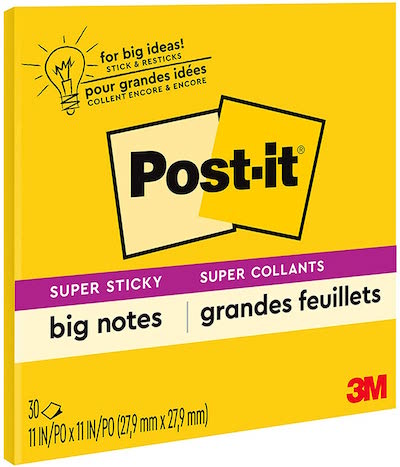
- Paper Doll Helps You Find Your Ideal Analog Habit Tracker — They may look like they’re just tiny scraps of paper, but both traditional sticky notes and specialty items (mini-lists, planners, and habit-trackers) in the Noted by Post-it® line offer cheery solutions for keeping your life organized. We looked at an expanded view of some of the Noted products in In Search of Lost Time: Productivity, Proust, and the Culture of Availability.
So, let me be perfectly clear: stickies have have a place in organizing — as long as they’re used intentionally, mindfully, and not randomly.
With all this in mind, today’s Paper Doll post explores another intriguing sticky note option reminiscent of the novelty we discussed back in 2012 when I looked a different transparent office supply solution, in Paper Doll Rolls the Highlight Reel: Removable Highlighter Tape.
BENEFITS AND USES OF TRANSPARENT STICKY NOTES
When it comes to organizing thoughts and information, I want the benefits of transparent sticky notes to crystal clear.
In case you’ve never seen a transparent sticky note, think of it as combining the functions of tracing paper and sticky notes.
Transparent sticky notes — which, to be fair, I generally more translucent or slightly “frosted” than entirely transparent — offer several benefits that distinguish them from traditional opaque ones, especially for organizing and annotating. Additionally, the notes (though not the writing) are waterproof and are generally more durable than traditional sticky notes.
Having trouble envisioning how they work? Take a peek:
Academic Uses
Transparent sticky notes are ideal for students at all levels, but particularly in high school and college, especially when studying texts where annotations are helpful or even necessary but the page or document must not be permanently altered.
Transparent sticky notes allow students to scribble questions, ideas, connections, and thoughts directly over content. The notes can be applied, easily removed or repositioned, and (if carefully stored) applied again later.
- Overlay Text or Drawings Without Obscuring What’s Beneath
Transparent sticky notes allow you to place and affix notes directly over text or diagrams without covering the printed content.
This is particularly useful for annotating books and textbooks, source documents, or presentations where you want to preserve visibility of the original material.
Science textbooks often include complex illustrations of plants, processes, or anatomical design. Students can learn a few elements at a time, add explanatory text to the overlaid sticky notes, remove the note to test themselves, and create new ones for different elements.
- Highlight and Emphasize Information
By placing a transparent sticky note over a portion of text or an image, you can use a highlighter or writing implement to highlight, annotate, or draw attention to specific details without making permanent marks on the original material.
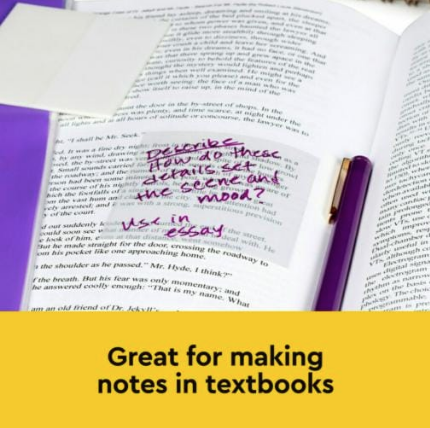
You can use a highlighter directly on a clear transparent sticky note; tinted translucent notes let you both color code concepts or categories and serve the same accenting purpose as a traditional highlighter.
Teachers can write comments pointing to specific areas of a student’s work while not damaging the masterwork, and tutors can add explanatory guidance to notes and then remove them when coaching students to remember what was on them.
Students using printed textbooks can highlight or annotate content, remove and re-affix the notes for studying and self-testing, and then re-sell the practically pristine textbook to the college bookstore after the final exam! (Yes, I know college students primarily use digital textbooks now, but they still read many novels and auxiliary books and use workbooks in traditional formats.)
- Copy content to paste into notes
Remember how I said that transparent sticky notes work like a combination of a traditional sticky note and tracing paper? Trace directly from your text book and then affix what you’ve traced into your handwritten notes.
The hand-brain connection means that students will remember the material much better from the experience of hand-tracing than they might if they only photocopied an illustration or chart.
Organizational Uses
This is an organizing blog, after all, so we should look at the organizing advantages.
- Layer for Enhanced Organization
You can layer transparent sticky notes on top of one another or over documents without losing sight of the information underneath. This can be useful in complex planning, when you want to group ideas visually without obscuring the main content.
Again, students can use layering for studying illustrations or maps, adding their notes and layering different types of content on top of the original material, with layer upon layer adding more nuance and detailed information. (I’m reminded of my 9th grade Social Studies class where, when faced with a blank mimeographed map of Africa, we had to learn (and later fill in on subsequent weeks), the country names, then the capitals, then the colonial influences, and the top exported product. I could have really used transparent notes, but regular Post-it® Notes hadn’t made it to our school supplies yet!)
- Reorganize Ideas Easily
One of the great benefits of traditional sticky notes is that you can move them around, but again, transparent/translucent sticky notes augment that benefit. They allow for more flexible, real-time organization of thoughts, whether they’re used on a document or handout, the page of a textbook or workbook, or even on a large-format item like a map, poster, or whiteboard.
Improve Every Stage of a Project
When you work (or study) in a creative field, your work often has many iterations. Having an overlay for things that aren’t (yet) perfect gives you flexibility to be creative without fear of losing a creative draft or burst of genius.
- Clear the Way for Creative Work
Transparent sticky notes can help for artists, designers, and creators who need to annotate their thoughts without hiding underlying sketches or design elements. Create temporary markups and adjustments without altering the original work.
Musicians might create an overlay with the conductor’s suggestions written on an angle, above or below the measures, bars, and notes.
- Collaborate and Brainstorm
In collaborative environments — picture a Mad Men-style creative team or a garage band figuring out how different instruments and vocals might come together — transparent sticky notes enable participants to add thoughts or ideas on top of shared content, whether on a design, blueprint, or lyric sheet.
The ability to make changes without altering the original fosters more flexible brainstorming sessions without fear of losing track of the original document or a sequence or flow of ideas.
Who else might use transparent sticky notes?
The unique properties make transparent sticky notes a versatile option in various context. In addition to traditional students and teachers in an academic setting, who else might use these notes?
- Authors — Most authors now edit galley copies of their books digitally, directly in PDF files. However, editing that way isn’t always comfortable. Writers might choose to make notes (on clean copies of their galleys or even printed drafts) and then highlight changes on transparent stickies.
- Memoirists — Reading your own handwritten journals to help document the history of your thoughts and actions? You probably don’t want your 2024 handwritten notes directly on the pages of your circa-1981 Snoopy diary, but overlaying transparent sticky notes helps the you in the present engage with the you of the past.
- Researchers — When faced with a variety of primary sources that can’t be doodled upon (or when you don’t have access to a copy machine but would prefer to handwrite your notes layered over a document), a transparent note can help you make a deeper connection between your thoughts and the original work than taking notes on a computer or pad of paper.
- Book reviewers — Whether you review books professionally or just for Amazon or Goodreads, it’s helpful to have your contemporaneous thoughts while reading and your highlighted quotes at the ready. If you find marking up books to be almost sacrilegious, transparent stickies are a great option.
- Cooks — Some people take recipes in cookbooks as gospel; others like to “doctor” things up. If you were experimenting as you went, you might not want each changed variable to be written onto the original recipe, but you’d still want to track the changes you made until (or even after) you achieved delicious perfection. TheKitchn blog post This Mind-Blowing BookTok Trend Will Change the Way You Use Your Cookbooks is a bit hyperbolic but does show the use case in action.
- Attorneys — Boilerplate contracts are in computers, and paralegals make the revisions digitally as instructed. But most lawyers can be seen reviewing photocopies of contracts and mocking them up with revisions. Transparent sticky notes would let them see the original contract language, highlight relevant passages, and make revisions; similarly, they might use transparent notes to help them accent points in transcribed depositions and testimony they want to refer to in court.
- Spiritual adherents — Whether you participate in some kind of formal Bible study or just like reading holy texts from any of a variety of comparative religions, you probably don’t want to scribble your thoughts in the (or any) “Good Book.” Use transparent sticky notes to highlight and annotate questions, feelings, or motivational elements.
- Crafters — Whether you’re trying to map colors for a needlepoint project or adjust the measurements on a pattern, writing directly on the instructions or designs can get messy, especially if you need to revise your notes. A transparent overlay lets you adjust without the mess.
How might you use a transparent or translucent sticky note?
CHALLENGES PRESENTED BY TRANSPARENT STICKY NOTES
While transparent sticky notes offer many benefits, they do have some downsides to consider.
Potential for Residue
Some brands of transparent sticky notes might leave a slight residue, especially if left on delicate surfaces for an extended period. (Bibles and textbooks from before the1950s tend to have pages that are as thin as tissue paper.)
Obviously, this varies depending on the quality of the adhesive used, and higher-end (and honestly, brand-name) versions will typically avoid this problem. If the book or document you’re using is delicate, test it on a back page, like in the glossary or index.
Adhesive Strength
Transparent sticky notes may not be adhere as strongly as traditional opaque sticky notes, particularly on rougher surfaces. Unlike the recycled paper of traditional sticky notes, the slightly slick material used to make transparent sticky notes makes the notes more durable but the adhesive may be less durable. This means they might peel off more easily, especially on surfaces that aren’t perfectly smooth or when the notes are repositioned (or applied, removed, and re-applied) multiple times. Again, test them.
Writing Challenges
Depending on the material, certain pens and markers may not write as well on transparent sticky notes. This can limit their functionality (compared to traditional paper-based sticky notes) if you (like Paper Doll) prefer one specific type of pen. Again, brand-name versions are likely to allow a greater variety of pen use; Post-it® shows multiple examples of workable writing implements.
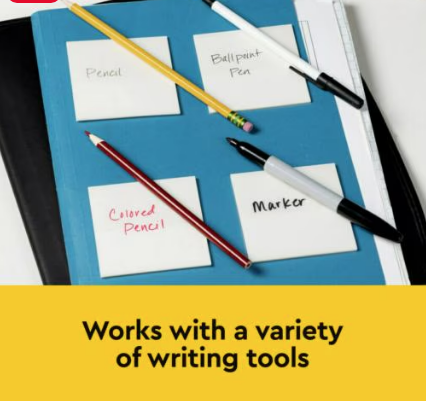
Less Absorbent Surface
Unlike paper sticky notes, which easily absorb ink, transparent sticky notes are usually made from plasticky or filmy material, like stiff, glossy tracing paper. This can cause ink to smear or take longer to dry.
Most of the TikTok videos I found on the topic are in agreement that mechanical pencils, ball-point pens, and markers work best, and that water-based highlighters and pens are the least effective. If you use markers or gel pens, especially if you also intend to highlight what you’ve written, be sure to let the ink dry thoroughly before touching or highlighting.
Limited Color Options
While some transparent sticky notes come in pastels and neons, they usually lack the range of vibrant colors available with opaque sticky notes, especially the myriad Post-it® colors. This can limit your ability to color-code effectively when organizing ideas. You can easily find colorful options, but perhaps not your preferred color schemes.
Glare and Reflection
Due to their transparent nature, this kind of sticky note may glare under certain lighting conditions, making them more difficult to read or see clearly in brighter environments or on glossy surfaces.
Cost
Transparent sticky notes, whether brand name Post-it® versions or generic, tend to be slightly more expensive than their opaque counterparts, so if you’re on a budget or need a lot of them, the cost could be a drawback.
If you’re using these sticky notes for creative, academic, or professional purposes where clear visibility is key, these downsides may be manageable. However, for heavy-duty or everyday use, traditional sticky notes are usually going to be more practical.
VARIETIES OF TRANSPARENT STICKY NOTES
According to the website, Post-it® Transparent Notes come in 7 varieties, all with 36 notes per pad (though I was able to find an additional 10-pack of the clear version at Staples.com for a whopping $26.46)!
- original transparent (clear) pad ($7.29 at Staples.com or $5.35 at OfficeSupply.com)
- a two-pack with one original clear pad and one blue pad
- a three-pack assortment (pink, orange, and green) pads ($12.59 at Quill)
- a five-pack assortment (purple, orange, pink, blue, and green)
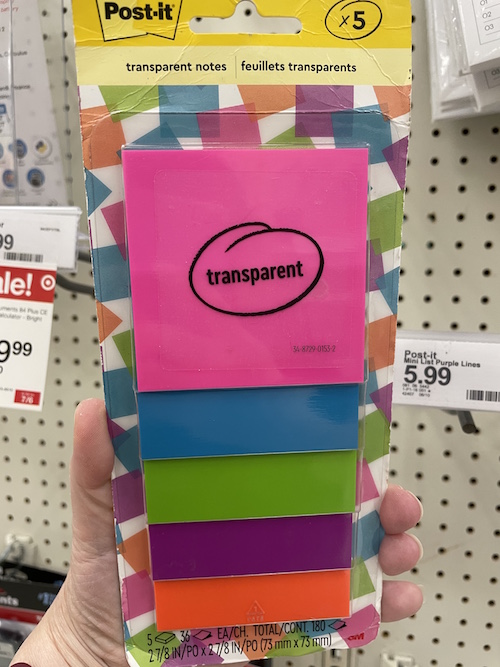
- an eight-pack with four clear pads and one pad each of orange, pink, blue, and green
- an eight-pack with two pads each in blue, pink, green, and orange ($14.99 at Amazon)
Paper Doll Explores New & Nifty Office and School Supplies
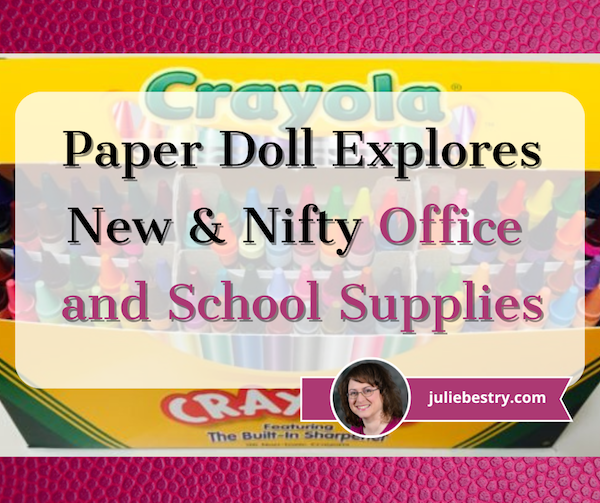
There’s something about the start of September that makes many of us hearken back to our youth and the rich potential of a fistful of new school supplies. Cast your mind back and I bet you can recall your favorite crayon. Mine was periwinkle, more for the funny name than the demure hue. (As you might imagine from my wordy posts, and as Paper Mommy will quickly confirm, I’ve never exactly been demure.)
It doesn’t matter whether you’re in kindergarten or graduate school; it doesn’t matter whether you’re being forced to return to the office after a few years of remote work or ready to embark on setting up your own home-based workspace, there’s something powerfully motivating about new office supplies and decor to help you get and stay organized and enthused.
The point of today’s post is not to encourage you to purchase clutter and pile unnecessary items up around your workspace; nor is it to give you lists of supplies you and/or your tiny humans already have. Rather, it’s an opportunity for you to see the potential of your space in a new way and consider what features or colors might boost your enthusiasm.
STICKY NODES
Post-it® Notes are fun and colorful, but they’re not entirely environmentally friendly, even when recyclable. Dry-erase (and wet-erase) boards are better for the planet, but they’re usually drab white and lacking delight.
Meet Sticky Nodes — the best of both worlds — they’re dry-erase sticky notes!
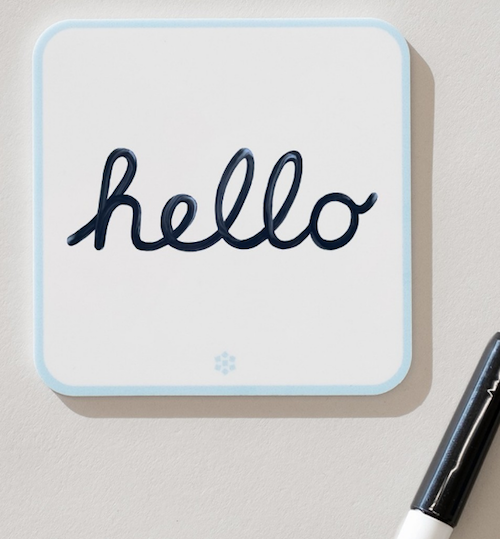
Sticky Nodes are:
- Erasable — Write with dry- or wet-erase markers, then wipe (or spritz and wipe) to start fresh.
- Restickable — Affix Sticky Nodes to any smooth surface, reposition at will, and they won’t leave a mark. Sticky Nodes use a unique “smooth-stick,” adhesive-ree technology, so you don’t have to worry about damaging your paint job.
- Reusable — Re-use face of the Sticky Node by erasing with a dry-erase marker or a damp cloth; re-use the whole Node by moving it to where it’s needed, over and over again.
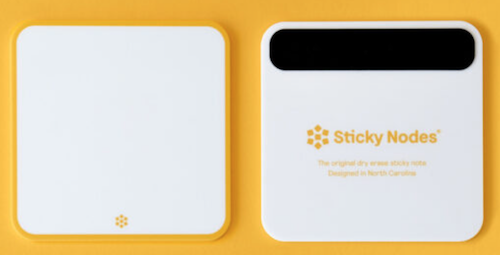
Around the office, at school, or in your home, put them on file cabinets or walls, whiteboards or chalkboards, mirrors or windows.
Capture and organize your genius thoughts, scribble notes, brainstorm on your own or with your need, or mix-and-match to help you study or tech. At home, post the WiFi password of the day draw a comic to greet your tiny human at the end of the school day. Your kids can keep track of weekly schedule items in their lockers, and at the office, you can make clear when you’re available to be bothered or to be left alone. Stick Nodes have all the same uses as sticky notes, but you don’t have to fill your trash can.
As noted in the video, products in the line can be affixed to the walls with adhesive or mounted (using screws), and some of the products are magnetic and can be used to attach the to metal items (like filing cabinets) or to other products in the line. Poppin has:
- wall shelves ($25), measuring 3.25″W x 4″H x 12.5″D, in blush, dark grey, slate blue, and white

- wall pockets ($25), measuring 12.5″W x 7″H x 2.5″D, in blush, dark grey, slate blue, and white
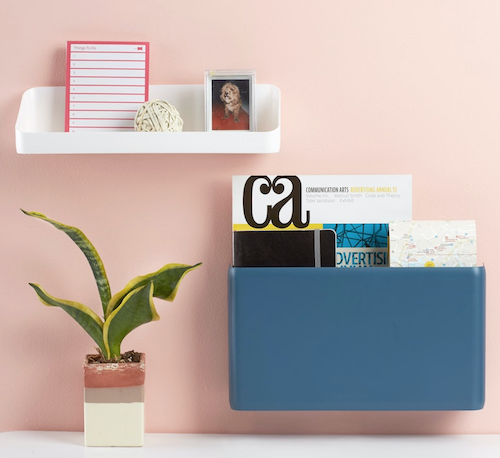
- wall cups ($14.50), measuring 4.5″W x 4.5″H x 2″D, in white, blush, dark grey, and slate blue
Each of the above products in the line are made of sturdy plastic polystyrene with a matte finish and come with removable adhesive strips, magnets, and screws for mounting. The removable adhesive strips hold up to 2 pounds; the magnets hold up to 1 pounds, and screws hold up to 15 pounds.
Poppin also makes dark grey fabric pinboards in two sizes, a 12.5″L x 12.5″W x 0.5″D square ($29) and a 25″W x 12″H jumbo version ($55).
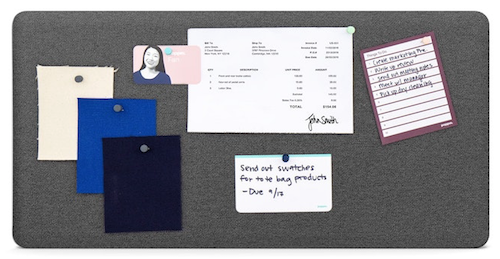
And, of course, they have a variety of pretty pushpins in assorted colors. But what I like best about Poppin’s “small space” line for making good use of vertical space is a product (actually three) they barely promote. There’s the white magnetic dry erase board ($26), measuring 12.5″W x 12.5″H x 0.5″D. But let’s face it, a plain white dry-erase board, even a magnetic one, isn’t that much to write home about.
But two other versions, with the same measurements and at the same price, up the ante. There’s the lined White Magnetic To-Do Dry-Erase Board:
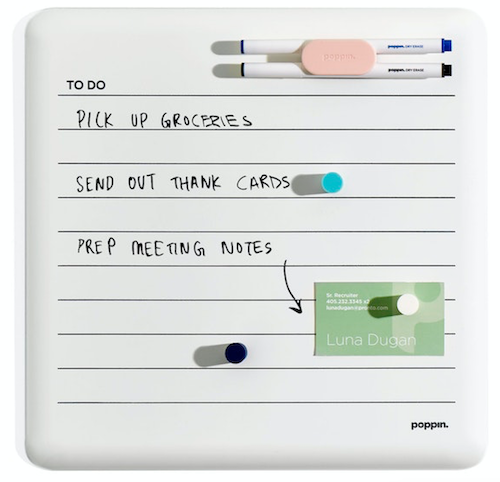
and the lined White Magnetic Weekly Dry Erase Board, pre-printed with the days of the week.

Of course, Poppin has pretty magnetic holders for the dry-erase pens and matching-color magnets.
Can’t you see these doing triple-duty at home, work, or in a dorm room?
TIKTOK MADE ME BUY IT
OK, TikTok didn’t actually make buy anything, but that’s what the voiceovers on so many of the little “advertainment” videos say. But TikTok did help me find two intriguing products.
PrintRGo
The first nifty office/school supply I saw recently kept appearing in my TikTok feed. It’s a tiny printer, and while I’m not the kind to push gadgets, I immediately saw the appeal of the PrintRGo thermal pocket printer. (Make sure you use the menu in the top right corner to switch from UK to US pricing.)

The use case may seem narrow, but if you’ve ever taken a biology course and had to label parts of a cell — and remember that the mitochondria is the powerhouse of the cell — or an studied for anatomy class where you had to learn a complex series of muscles, you know that you learn by spaced repetition and visual support.
Free-hand drawing and labeling is a pain, as is making copies. This little 3.4″ × 3.5″ × 1.6″ printer uses no ink, so you never have to wait for the ink to dry; instead, it uses adhesive-backed thermal paper to print at a maximum resolution of 203 DPI. (It does double-duty, so it also works some fun magic as a low-resolution photo printer and a label printer.)
Unfortunately, TikTok videos don’t embed particularly well, but this link will give you an idea of how the PrintRGo works.
In each box, you get a PrintRGo printer, charging cable, one roll of thermal paper, and a user’s manual. PrintRGo works via Bluetooth using the Phomemo app, and functions Android and IOS devices. It’s wireless, so you just pair it with your phone (just as with other Bluetooth devices like a Fitbit or keyboard) and you’re ready to print!
Take a photo with your phone, use the app to print it from your PrintRGo, and it thermal prints to sticker paper (at a speed of 10mm per second), and once you have your little masterpiece, printouts can adhere to your notebook or study cards.
Full-price for the PrintRGo is $78, but it’s currently selling at the official website for $48.
If you’re not comfortable purchasing from a TikTok advertiser, Amazon has a number of similarly adorable options that seem to work on the same principle, using the same Phomemo app. One version is the Phomemo M02 Pocket Printer ($49.99).
Bookmate
The other TikTok school/office supply that caught my attention disappeared from my feed (as often happens) when I fat-fingered (fat-thumbed?) the corner of my phone. No matter, because my fabulous friend and colleague Hazel Thornton independently sent it to me in a private TikTok message with a note, “New product for a blog post?” Indeed, it is!
Bookmate from AchieversMust appears to be designed primarily for teachers and students, but really anyone who reads and tends to annotate, take notes, or mark pages for followup will find it useful for reducing clutter. Bookmate combines one magnetic case (which holds sticky tape flags for marking pages and pen loops so you always have a writing tool or highlighter handy) and a magnetic base.
The case allows for you to refill the sticky flags, and you can use any standard tape flags to refill the Max or Pro cases, or purchase the same specific colors from AchieversMust. (You can only refill the Lite version with their tape flags. FYI.)
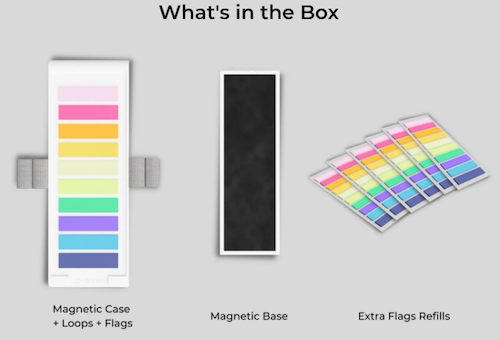
You put the magnetic base inside the front of your book or notebook and the magnetic case (with your tape flags and pens) sticks to the front. (The company claims the magnet is strong enough to adhere through a hardcover book, but I’m a twinge dubious.)
Some photos show users hanging glasses or sunglasses from an outer loop. Again, TikTok videos are wackadoodle when it comes to embedding, but you can see Bookmate in action on the Instagram page.There are three versions of the Bookmate:
- Max — has four pen loops (two on each side) and a 200-count of flags in ten different colors, for $39.95
- Pro — has four pen loops (two on the left, two on the right) (two on each side) and a 100-count of flags in six different colors, for $33.95
- Lite — has two pen loops (one on each side) and an 80-count of 2 different tape flags, for $19.95
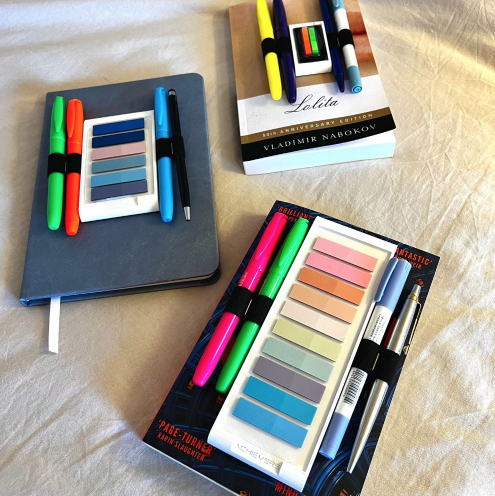
They offer free shipping on all orders above $60. Also, from now through September 10, 2023, you can buy two at 10% off each or buy 3 at 25% off each. (There’s also a 30-day money-back guarantee.)
EVERYTHING OLD IS NEW AGAIN
I remember visiting my father’s law office when I was a child, and I noticed that every attorney’s desk had a serious-looking leather desk pad. As a student in the 80s, my real work desk was wherever I found myself — a library study carrel, my bed, a random table in an empty classroom. By the time I started working in television, the closest anyone seemed to get to a desk pad was a giant desk calendar.
Nowadays, nobody is using a desk pad for blotting a fountain pen, but desk protectors are back in style. I was roaming through a big box store this weekend, looking for a lightning cable to use in my rental car (as mine is still in my stolen, damaged, recovered, and still-not-repaired Kia), when I noticed a stack of what looked like miniature yoga mats.
It turns out they were oversized desktop mouse pads. The one that caught my eye was a 35″ x 16″ pink, flowered, onn.-brand (yes, it’s “onn.”) XL Desktop Mouse Mat with an anti-slip base. The style is called Surf. (It also comes in grey and rainbow-stripes.)
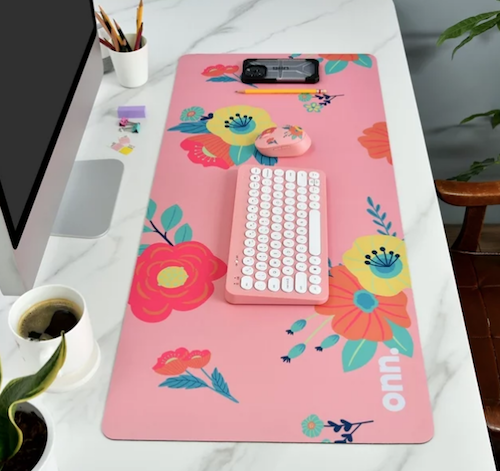
And it was only $9.88!
It’s been a long time since I looked for a mouse pad or a desk mat, so I was surprised and delighted by how many products, marketed as either oversized mouse pads or desk pads, were available to brighten up the work space.
Yes, the real purpose is to give you a larger space to roll your mouse while keeping your glass or wooden desktop free of scratches, spills, dust, stains, and all matter of the detritus that ends up crumbly and sticky and yuckified on your desk. But why not feel like you’re basking luxury while doing homework or eking out a living?


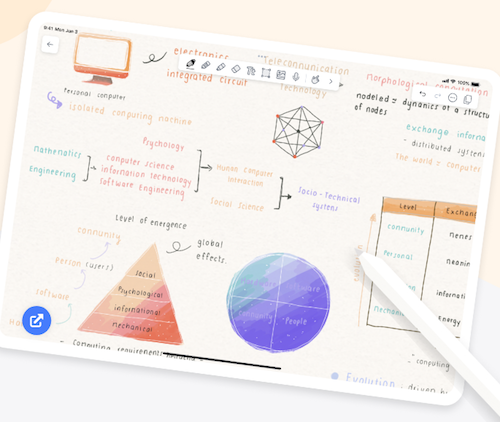
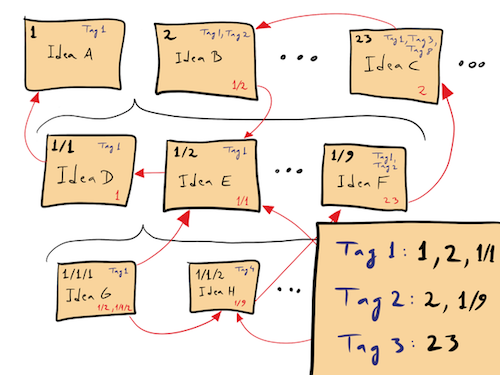




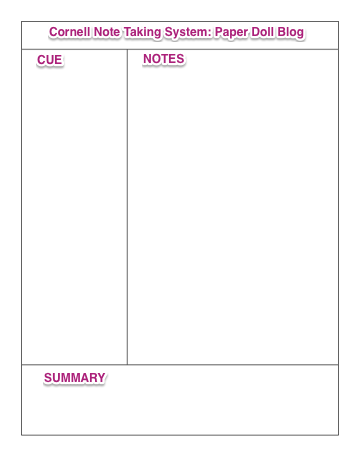



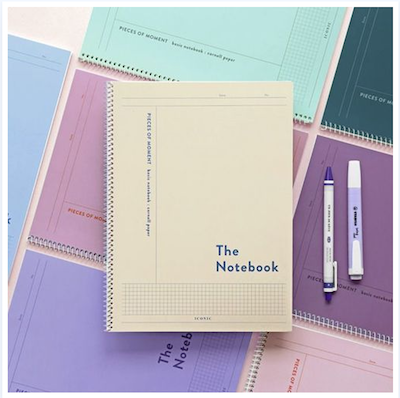

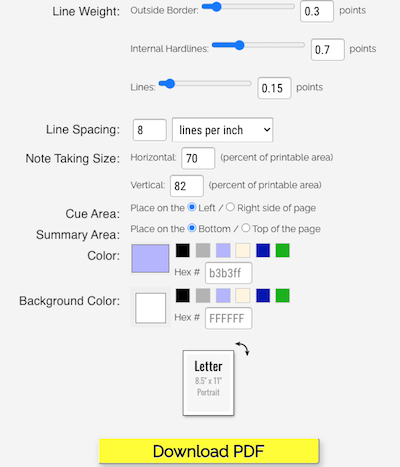



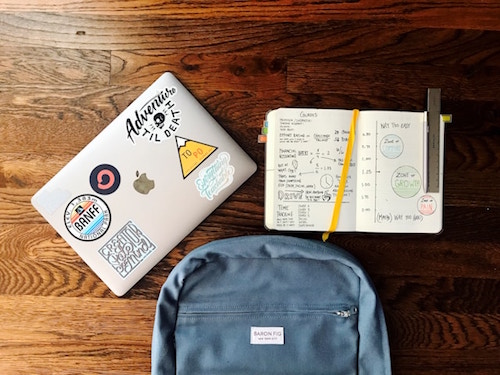
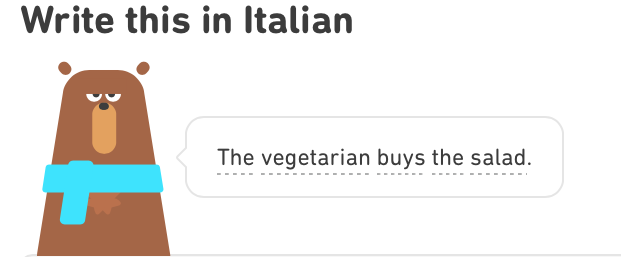



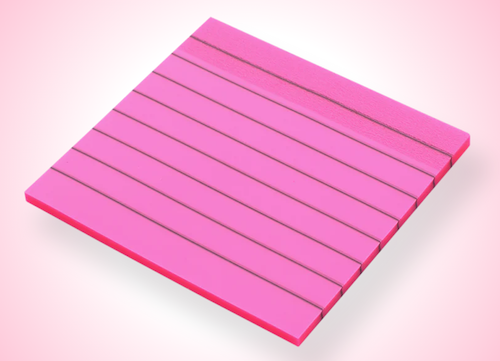 (I’ve yet to figure out how TikTok Shop advertisers and companies like Temu and Shein can afford to price their products so low. Caveat emptor.)
(I’ve yet to figure out how TikTok Shop advertisers and companies like Temu and Shein can afford to price their products so low. Caveat emptor.)

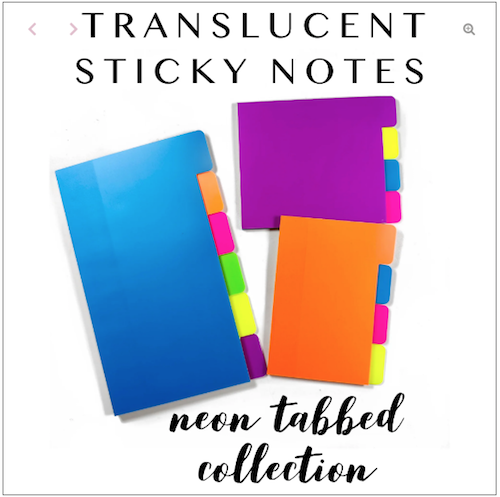

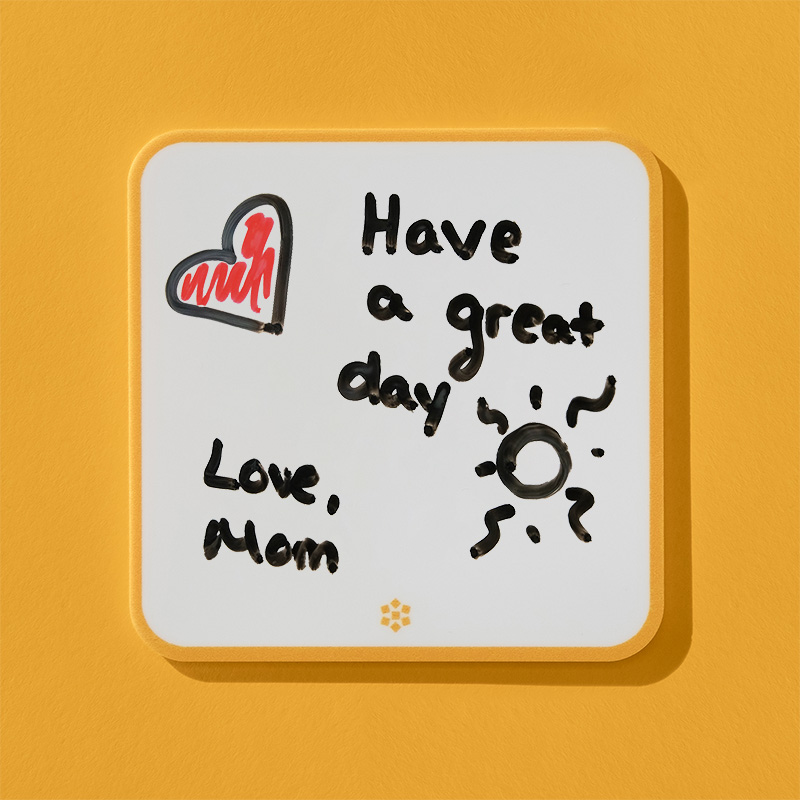
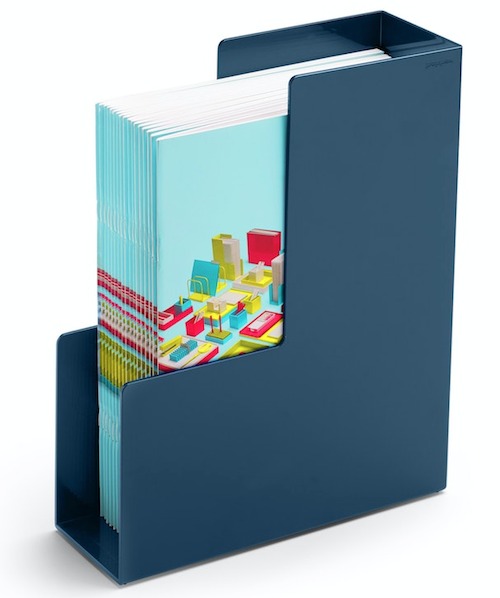
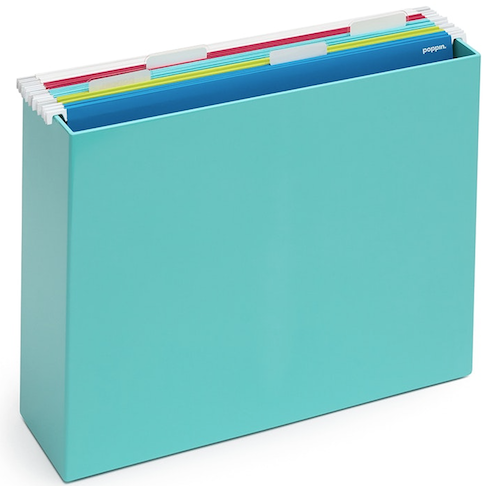
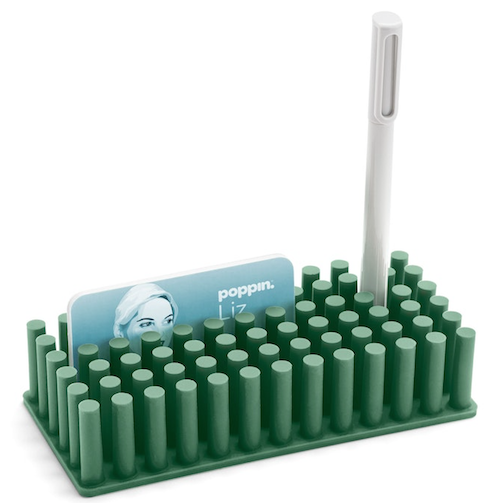





Follow Me